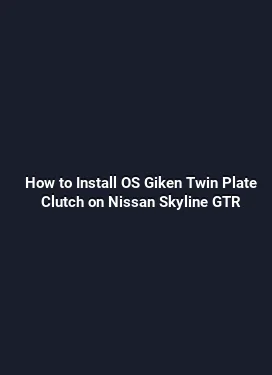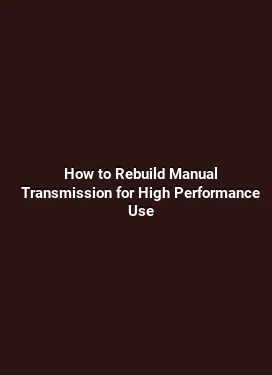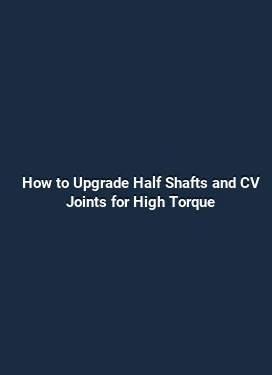How to Install Clutch Delay Valve Delete on Modern Manual Cars
Clutch delay valves (CDVs) are designed to modulate hydraulic pressure to the clutch when the pedal is released, aiming to smooth engagement and protect drivetrain components. In many modern manual transmissions, the CDV can introduce a perceptible delay in clutch disengagement, which some drivers find undesirable for aggressive or precise shifting. A clutch delay valve delete removes this limiter, potentially yielding a crisper pedal feel and quicker engagement. Implementing this modification requires careful preparation, a clear understanding of the vehicle’s hydraulic system, and meticulous reassembly to maintain overall reliability.
Understanding the Purpose and Effects of a Clutch Delay Valve

Clutch delay valves are integrated into the hydraulic circuit to regulate movement of the clutch hydraulics during pedal operation. By altering the flow and response, they can dampen system oscillations and reduce shock loads on the transmission, especially during heel-toe maneuvers or abrupt engagements. However, this damping can also soften input responses, delaying full engagement. The impact varies by model, clutch type, and the hydraulic line routing in the master cylinder and slave cylinder assembly.
Before proceeding, it is essential to recognize that removing a CDV can influence how quickly the clutch disengages, the feedback through the pedal, and the overall shift synchronization. In some cases, unintended changes in pedal travel, clutch wear, or transient behavior may occur if the system is not properly re-tuned or bled after the modification.
Key factors influenced by the delete

The immediate changes you may notice include a firmer pedal feel, reduced travel before engagement starts, and a more direct connection between pedal input and clutch actuation. Over time, if the hydraulic system is not properly bled or if residual air remains, there can be sponginess or inconsistent clutch release. Understanding these dynamics helps set realistic expectations and informs the installation approach.
Identifying the CDV and Planning the Delete
Successful CDV deletion begins with accurate identification of the valve location and the associated plumbing. The CDV is typically integrated into the hydraulic line near the master cylinder, slave cylinder, or within a dedicated inline assembly close to the pedal cluster. Accessing it may require removing panels, shielding, or components of the pedal box. A precise map of the vehicle’s hydraulic routing helps avoid disturbing unrelated parts.
Planning involves gathering the right tools, ensuring you have replacement o-rings or fittings if needed, and having a plan to bleed air from the system after modification. It’s also prudent to inspect the condition of the master and slave cylinders, hydraulic lines, and connectors to ensure they’re free of leaks and corrosion before making any changes.
Recommended assessment steps
Begin with a clean diagnostic of pedal feel and clutch engagement in standard driving conditions. Note pedal travel, engagement point, and any sponginess. Compare these observations to the expected change after the delete. Mapping out the route of the hydraulic hoses helps prevent accidental damage during disassembly. If the vehicle has multiple hydraulic branches or integrated electronic lift systems, special care is needed to avoid triggering warning indicators or abridging safety interlocks.
Tools, Parts, and Safety Precautions
Performing a CDV delete requires a combination of mechanical and hydraulic expertise. Assemble a clean, organized work area with proper lighting. The following tools are commonly used for this task: a set of metric wrenches and sockets, line wrenches for hydraulic fittings, special pliers for hose clamps, a brake master cylinder clamp or suitable support, a clear hose for bleeding, a catch container, brake fluid compatible with your system, and a bleed kit or vacuum bleeder for air removal. Mechanical safety equipment such as gloves and eye protection is essential.
Safety considerations include ensuring the vehicle is on a stable surface, the braking system remains uncompromised, and the battery is disconnected if any electrical connections or pedal sensor wiring are touched during the procedure. It is important to avoid introducing air into the system and to work methodically to maintain system integrity. If the vehicle features an electronic pedal position sensor or a drive-by-wire interface for the clutch, additional precautions may be necessary to preserve calibration or to avoid warning lights after reassembly.
Selecting the right approach
There are several routes to remove a CDV, depending on the vehicle’s design. Some routes involve bypassing a dedicated valve by installing a straight-through hose segment or replacing the valve with a compatible plug or shorter line. Others require routing a new line path to maintain clearance and avoid interference with other components. In every case, the objective is to minimize flow restriction while ensuring the system remains sealed and free of air after reassembly.
Step-by-Step Installation Process for Clutch Delay Valve Delete
This section describes a generic approach. Always refer to the vehicle’s service manual and, if possible, obtain a model-specific guide from reputable sources or enthusiast communities. The steps emphasize careful disassembly, precise reassembly, and thorough bleeding to restore consistent clutch operation.
Preparation and safety checks
1) Park the car on a flat surface, engage the parking brake, and disconnect the negative battery terminal to prevent accidental short circuits. 2) Clean the surrounding area to prevent contamination entering the hydraulic lines. 3) Inspect the hydraulic reservoir for contaminants or discoloration; replace if necessary. 4) Gather all required parts, including any replacements for the CDV assembly and compatible fittings. 5) Review torque specifications for any bolts or fittings that will be loosened during disassembly.
Accessing the valve and removing the CDV
Carefully remove panels or components that obscure access to the CDV. Identify the valve assembly within the hydraulic line near the master cylinder or transmission bell housing. Loosen the fittings while supporting the line to prevent bending. If the valve is integrated with a metering device or sensor, disconnect any electrical connectors with care and take note of connector orientation for reassembly.
Once the CDV is exposed, assess whether the valve is suitable for bypass or replacement. If bypassing, ensure the alternative routing maintains clearance from moving parts and heat sources. If replacing with a plug or a shorter line, ensure the new component provides a proper seal and does not introduce dangerous pressure variations in the system.
Implementing the bypass or replacement
Install the chosen bypass or plug with clean, lubricated threads and tighten to manufacturer torque specifications. For inline bypasses, ensure the hose clamps are secure and free of leaks. If a new line is introduced, route it along the existing path while avoiding sharp bends or contact with hot surfaces. Use protective sleeves or loom where appropriate to shield hoses from abrasion over time.
Bleeding the hydraulic system
Bleeding is critical after any modification to the clutch hydraulic system. Use the recommended method (manual bleed, pressure bleed, or vacuum bleed) and follow a consistent sequence to avoid trapped air. Begin at the slave cylinder closest to the pedal and work toward the master cylinder, rotating through each bleed point as indicated in the service guide. Monitor the fluid color and clarity throughout the process; fresh brake fluid should be clear and free of particulates.
Reassembly and initial test
With all lines secured and the system bled, reattach panels, ensure the pedal assembly is properly aligned, and reconnect any electrical connectors. Reconnect the battery, start the engine, and carefully test the clutch pedal with the engine at idle. A few light depressions before engaging the gears help confirm there are no leaks and that the pedal responds consistently. If a warning light appears or pedal feel changes noticeably, recheck for air or leaks and verify sensor connections.
Diagnostics: Assessing Driving Feel After the Delete
After completing the installation, a measured assessment of the clutch’s behavior is essential. Expected outcomes include a more direct pedal response and a perceived reduction in the travel required to disengage the clutch. The engagement point during takeoff can shift slightly, becoming either crisper or more abrupt depending on the system’s initial condition and the driver’s technique. It is important to differentiate between a more immediate response and a harsh engagement that could place increased loads on the transmission or drivetrain components.
To validate improvements, conduct controlled tests in a safe environment. Start with low-speed maneuvers, gradually increasing the load while ensuring no abnormal noises or vibrations arise. Pay attention to gear matching, especially when downshifting from higher to lower gears. If shifting feels inconsistent or the clutch remains partially engaged at the wrong times, recheck the bleed, lines, and mounting hardware for obstructions or leaks.
Impact on Performance, Reliability, and Long-Term Considerations
Removing a CDV can alter the feel and timing of clutch engagement, which in turn affects daily driving comfort and high-performance maneuvers. The potential benefits include a more immediate shift feel, quicker throttle response transfer to the drivetrain, and a sense of greater control for skilled drivers. On the downside, a louder or harsher engagement can occur if the hydraulic system is not properly purged of air or if the line routing creates new resonances under load.
Reliability considerations include ensuring long-term seals remain intact and that the modified system does not introduce unexpected stress concentrations on the master or slave cylinders. Regular inspection for leaks, cracks in hoses, and wear on fittings is prudent. It is also wise to monitor clutch wear and fluid condition over time, as a stiffer system may alter the rate at which the clutch engages and disengages, influencing wear patterns on the friction material.
Maintenance, Calibration, and Post-Modification Upkeep
Maintenance after a clutch delay valve delete centers on preserving hydraulic integrity and pedal reliability. Schedule periodic checks of fluid levels, color, and contamination. Replace the brake/clutch fluid at intervals recommended by the vehicle manufacturer or sooner if contamination is suspected. Inspect the hydraulic lines for any signs of hardening, cracking, or swelling, and address issues promptly to prevent leakage or performance degradation.
Calibration considerations include verifying that any pedal position sensors or electronic interfaces still function correctly. If the vehicle uses a drive-by-wire system for clutch operation, re-check the sensor calibration after reassembly and ensure there are no erroneous fault codes. A professional calibration or re-learning procedure may be advisable in some models to ensure optimal shift timing and engagement consistency.
Legal, Warranty, and Warranty-Related Implications
Modifying the clutch hydraulic system can affect warranty coverage and, in some regions, may influence vehicle certification or emissions-related components. It is important to review the vehicle’s warranty terms and consult with a dealership or certified technician if there is any concern about coverage after performing a delete. In some jurisdictions, significant alterations to the propulsion or transmission controls could have regulatory implications, so verify local guidelines and compliance requirements before proceeding.
Alternative Upgrades for Manual Transmissions
For enthusiasts seeking improved shift quality without altering the hydraulic system, several alternative upgrades can deliver meaningful results. Upgrades include high-quality transmission fluid formulations designed for smoother engagement, performance clutch kits that improve response, shorter-throw shifters for reduced travel, and improved linkages or bushings to minimize play in the shifter mechanism. Each option has its own impact on feel, noise, and reliability, so a balanced approach that matches the driver’s goals and the vehicle’s intended use is essential.
Practical tips for drivers considering these options
Test drives scattered across varied driving scenarios help isolate how each change affects daily driving. Document pedal effort, engagement point, and gear mesh smoothness before and after any modification. Consider keeping a maintenance log to track long-term effects and to ensure that any adjustments remain within safe operating parameters.
Common Pitfalls and How to Avoid Them
One frequent issue is insufficient bleeding or trapped air, leading to a soft or inconsistent pedal. Another common pitfall is improper routing that brings hoses into contact with moving components or heat sources, which can cause premature wear or leakage. Lastly, mismatched parts or incompatible fittings can create leaks or improper sealing. Mitigating these risks requires attention to detail during disassembly and reassembly, verifying the integrity of every connection, and following the vehicle’s service specifications closely.
Final Considerations for Driving Experience
A well-executed CDV delete can deliver a more direct clutch feel and a reduced engagement delay, aligning with a driver’s preference for precision and immediate feedback. The key to a successful result lies in thorough preparation, careful execution, and diligent post-modification testing. By approaching the modification with both respect for the vehicle’s hydraulic integrity and a structured testing routine, drivers can achieve a rewarding enhancement in shifting responsiveness without compromising safety or reliability.






